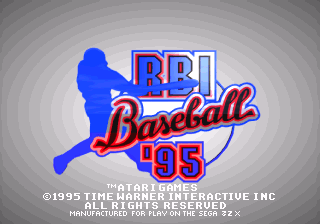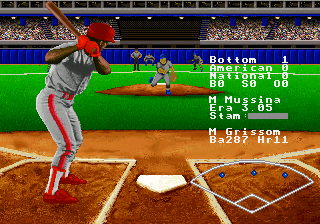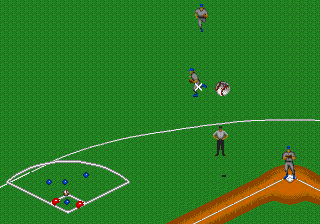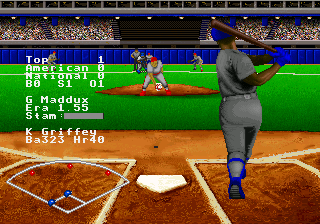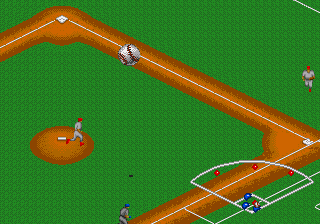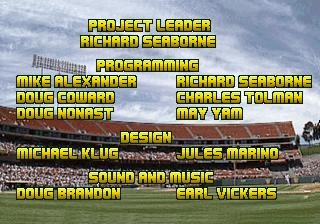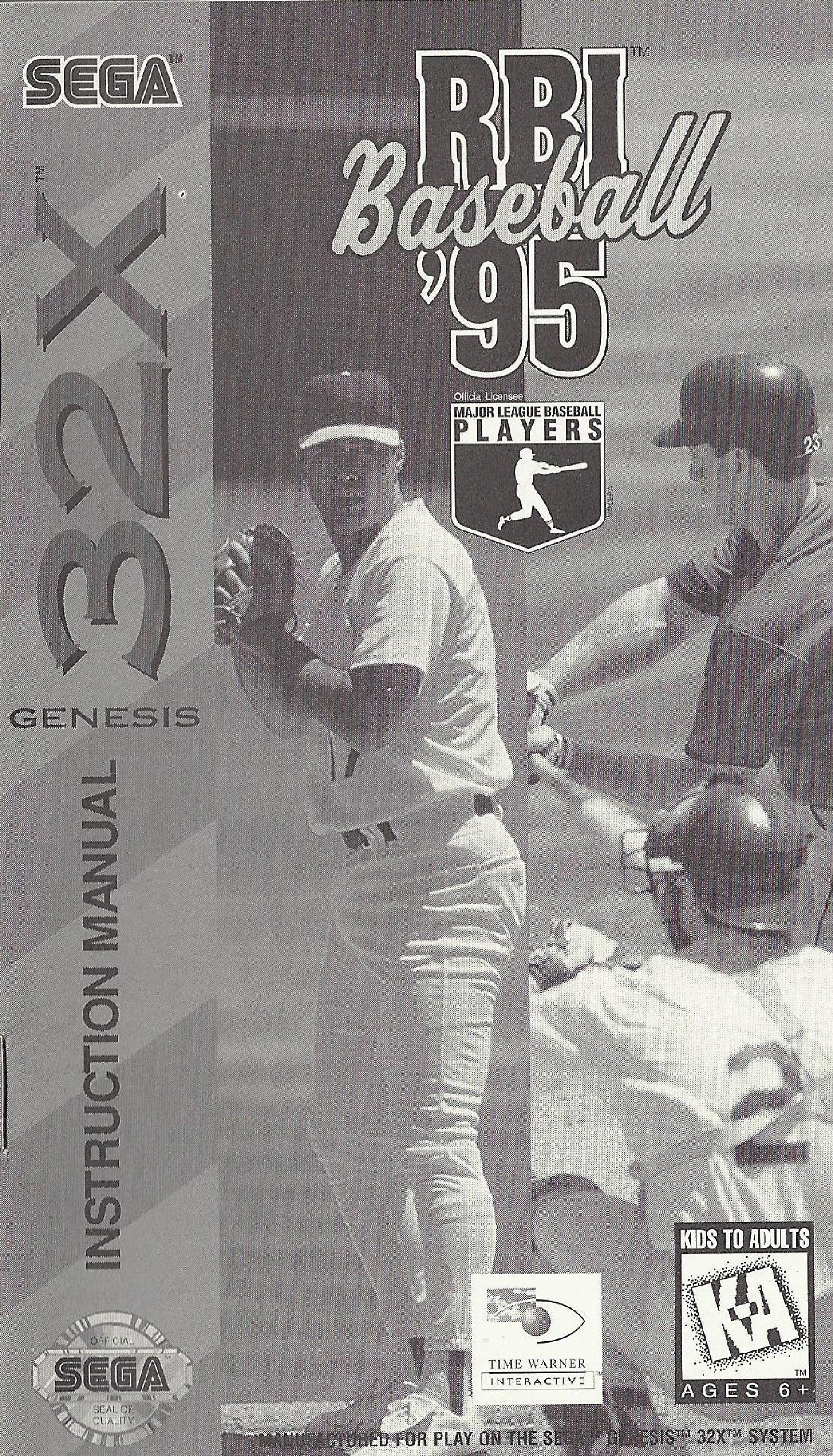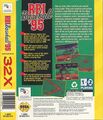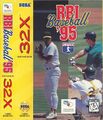RBI Baseball '95
From Sega Retro
- For the unreleased Sega Mega Drive game, see R.B.I. Baseball '95.
| RBI Baseball '95 | ||||||||||
|---|---|---|---|---|---|---|---|---|---|---|
| System(s): Sega 32X | ||||||||||
| Publisher: Time Warner Interactive | ||||||||||
| Developer: Time Warner Interactive | ||||||||||
| Licensor: Atari Games, Major League Baseball Players Association | ||||||||||
| Sound driver: GEMS | ||||||||||
| Genre: Sports (baseball) | ||||||||||
| Number of players: 1-2 | ||||||||||
|
RBI Baseball '95 is a baseball game developed and published by Time Warner Interactive exclusively for the Sega 32X in North America in 1995. It is the last game in the RBI Baseball series to be released on a Sega platform, following R.B.I. Baseball '94.
The history of RBI Baseball '95 history is curious as it was originally announced at CES 1995 for the Sega Mega-CD as well as the 32X, priced in the US at $49.95 and $54.95 respectively[2]. For some reason, the game instead moved onto a cartridge.
Contents
Gameplay
The game is a Major League Baseball game including the 28 teams and stadiums of the 1994 MLB season. The game carries a Major League Baseball Players Association license, so it contains all of the Major League Baseball players but not the team names or logos.
Unlike previous entries in the RBI Baseball, which used a high view from behind the umpire, RBI Baseball '95 has the player delivering pitches and hitting the ball from the catcher's point of view. Many of the sprites have been redrawn to take advantage of the increased color depth of the 32X. Commentary, provided by sportscaster Jack Buck, has been carried over from the previous game.
Modes
The game has the following modes:
- Play Ball: A nine-inning exhibition game between any two teams from either league (which can be the same team) or a series. The selectable series are Best of Seven (play any team in a best of seven playoff series), Play Division (play against every team in the 1994 American League, 1994 National League, American division winners, or National division winners), Play All Teams (play against every team in the game), 80 Game Season (a truncated season), or 162 Game Season (a full season). Series games use a password system for continuing.
- Home Run Derby: Players choose a team, a batter, and a pitch speed (60, 70, 80, 90, or 100). Each player gets 20 pitches and tries to hit as many home runs as possible. In two-player games, the stadium used belongs to player one's team. Awards are given for 3 (bronze), 5 (silver), 8 (gold), or 11 or more (grand prize) runs.
- Game Breakers: Players choose a team. Rather than starting a new game, players choose from a list of 17 situations, such as being down four points at the top of the ninth inning but having bases loaded, needing to make a comeback from being down nine points in the fourth inning, or entering a tie game at the bottom of the ninth inning with one runner on base. After choosing a situation, players choose a relief pitcher and finish the game with the selected premise. A password is given after each completed game.
- Create Teams: Players can create custom teams with any players, which can be used in any of the other modes.
- Stadium Tour: An overhead view of any of the 30 ballparks in the game (one for every team, plus an American League and a National League stadium).
- View Roster: View all of the team rosters and statistics for any player.
- Defense Practice: Practice playing defense in 20 different infield and outfield defensive situations. A computer-controlled batter hits a ball off a tee, and the player controls the fielders.
Games can be played as Human vs. Comp (single-player, where the player is the visiting team and bats first), Comp vs. Human (single-player, where the player is the home team and bats last), Human vs. Human (two-player game, where player two as the home team), or Comp vs. Comp (two computer-controlled teams play each other, which can be overridden by either control pad to take over play or make substitutions). Before each game, players choose any team and set the batting line-up and choose starting and relief pitchers. A pitcher can only start every other game in a series.
In the options, players can choose from three difficulty levels for computer-controlled opponents (Easy, Medium, and Hard), set the defense mode (computer-assisted for partial assistance or fully automated or manual fielding), or toggle errors (whether fielders occasionally make errors such as dropping the ball).
Teams
Current
The game includes all 28 teams from the 1994 MLB season, with their stadiums (following the three-division structure, which had premiered that year).
| League | Division | Team | Based on |
|---|---|---|---|
| American | West | California | California Angels |
| Oakland | Oakland Athletics | ||
| Seattle | Seattle Mariners | ||
| Texas | Texas Rangers | ||
| Central | Chicago | Chicago White Sox | |
| Cleveland | Cleveland Indians | ||
| Kansas City | Kansas City Royals | ||
| Milwaukee | Milwaukee Brewers | ||
| Minnesota | Minnesota Twins | ||
| East | Baltimore | Baltimore Orioles | |
| Boston | Boston Red Sox | ||
| Detroit | Detroit Tigers | ||
| New York | New York Yankees | ||
| Toronto | Toronto Blue Jays | ||
| National | West | Colorado | Colorado Rockies |
| Los Angeles | Los Angeles Dodgers | ||
| San Diego | San Diego Padres | ||
| San Francisco | San Francisco Giants | ||
| Central | Pittsburgh | Pittsburgh Pirates | |
| Chicago | Chicago Cubs | ||
| Cincinnati | Cincinnati Reds | ||
| Houston | Houston Astros | ||
| St. Louis | St. Louis Cardinals | ||
| East | Florida | Florida Marlins | |
| Montreal | Montreal Expos | ||
| New York | New York Mets | ||
| Philadelphia | Philadelphia Phillies | ||
| Atlanta | Atlanta Braves |
Previous
In addition, the game includes historical rosters of every division-winning team going back to 1986 (following the previous two-division structure).
| League | Year | West | East | ||
|---|---|---|---|---|---|
| Team | Based on | Team | Based on | ||
| American | 1993 | Chicago | Chicago White Sox | Toronto | Toronto Blue Jays |
| 1992 | Oakland | Oakland Athletics | Toronto | Toronto Blue Jays | |
| 1991 | Minnesota | Minnesota Twins | Toronto | Toronto Blue Jays | |
| 1990 | Oakland | Oakland Athletics | Boston | Boston Red Sox | |
| 1989 | Oakland | Oakland Athletics | Toronto | Toronto Blue Jays | |
| 1988 | Oakland | Oakland Athletics | Boston | Boston Red Sox | |
| 1987 | Minnesota | Minnesota Twins | Detroit | Detroit Tigers | |
| 1986 | California | California Angels | Boston | Boston Red Sox | |
| National | 1993 | Atlanta | Atlanta Braves | Philadelphia | Philadelphia Phillies |
| 1992 | Atlanta | Atlanta Braves | Pittsburgh | Pittsburgh Pirates | |
| 1991 | Atlanta | Atlanta Braves | Pittsburgh | Pittsburgh Pirates | |
| 1990 | Cincinnati | Cincinnati Reds | Pittsburgh | Pittsburgh Pirates | |
| 1989 | San Francisco | San Francisco Giants | Chicago | Chicago Cubs | |
| 1988 | Los Angeles | Los Angeles Dodgers | New York | New York Mets | |
| 1987 | San Francisco | San Francisco Giants | St. Louis | St. Louis Cardinals | |
| 1986 | Houston | Houston Astros | New York | New York Mets | |
All-Star
Finally, the game includes All-Star teams for each league going back to 1990.
| League | Team |
|---|---|
| American | 1994 American League All-Stars |
| 1993 American League All-Stars | |
| 1992 American League All-Stars | |
| 1991 American League All-Stars | |
| 1990 American League All-Stars | |
| National | 1994 National League All-Stars |
| 1993 National League All-Stars | |
| 1992 National League All-Stars | |
| 1991 National League All-Stars | |
| 1990 National League All-Stars |
Production credits
- Project Leader: Richard Seaborne
- Programming: Mike Alexander, Richard Seaborne, Doug Coward, Charles Tolman, Doug Nonast, May Yam
- Design: Michael Klug, Jules Marino
- Sound and Music: Doug Brandon, Earl Vickers
- Director: Bill Hindorff
- Graphics and Animation: Jennifer Case, Lindsay Dawson, Valerie Couderc, Doug Gray, Jose Erazo, Jules Marino
- Voices: Jack Buck, Walter Fields
- Special Thanks: John Arvay, Steve Calfee, Rob Boone, Chris Ebert, Mike Kruse, Our Video Lab
- Product Development: Bill Hindorff
- Manual Editor: Jon Mongelluzzo
Magazine articles
- Main article: RBI Baseball '95/Magazine articles.
Promotional material
also published in:
- VideoGames (US) #78: "July 1995" (1995-0x-xx)[5]
- Game Players (US) #0807: "Vol. 8 No. 7 July 1995" (1995-0x-xx)[6]
- VideoGames (US) #79: "August 1995" (1995-0x-xx)[7]
Physical scans
| Sega Retro Average | |||||||||||||||||||||||||||||||||||||||
|---|---|---|---|---|---|---|---|---|---|---|---|---|---|---|---|---|---|---|---|---|---|---|---|---|---|---|---|---|---|---|---|---|---|---|---|---|---|---|---|
|
| 60 | |
|---|---|
| Based on 7 reviews | |
Technical information
- Main article: RBI Baseball '95/Technical information.
References
- ↑ 1.0 1.1 GamePro, "September 1995" (US; 1995-xx-xx), page 76
- ↑ Press release: 1995-01-06: TIME WARNER INTERACTIVE MOVES MEGA-HIT R.B.I. BASEBALL SERIES TO NEW GAMING SYSTEMS
- ↑ File:RBI Baseball 95 32X credits.pdf
- ↑ File:Rbibaseball95 32x us manual.pdf, page 30
- ↑ VideoGames, "July 1995" (US; 1995-0x-xx), page 99
- ↑ Game Players, "Vol. 8 No. 7 July 1995" (US; 1995-0x-xx), page 61
- ↑ VideoGames, "August 1995" (US; 1995-0x-xx), page 99
- ↑ 1700 igr dlya Sega, "" (RU; 2001-xx-xx), page 247
- ↑ GameFan, "Volume 3, Issue 6: June 1995" (US; 1995-xx-xx), page 110
- ↑ Game Players, "Vol. 8 No. 7 July 1995" (US; 1995-0x-xx), page 73
- ↑ Game Informer, "June 1995" (US; 1995-0x-xx), page 51
- ↑ Next Generation, "July 1995" (US; 1995-06-20), page 71
- ↑ VideoGames, "July 1995" (US; 1995-0x-xx), page 95
| RBI Baseball '95 | |
|---|---|
|
Main page | Hidden content | Development | Magazine articles | Reception | Region coding | Technical information | |
| R.B.I. Baseball games for Sega systems | |
|---|---|
| R.B.I. Baseball 3 (1991) | R.B.I. Baseball 4 (1992) | R.B.I. Baseball '93 (1993) | R.B.I. Baseball '94 (1994) | R.B.I. Baseball '95 (unreleased) | RBI Baseball '95 (1995) | |
